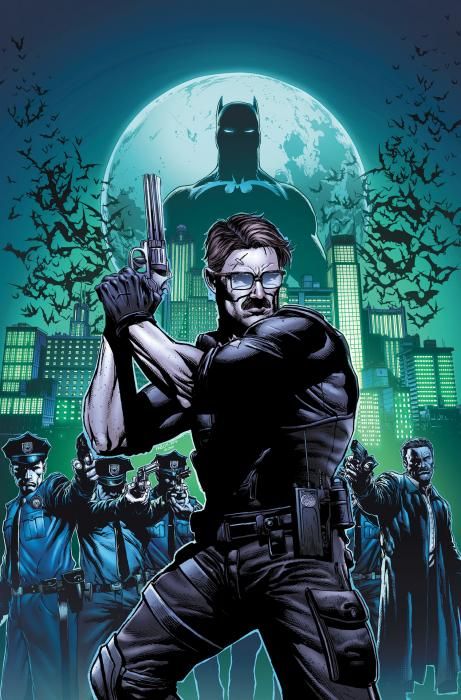"Detective Comics" #25 by John Layman, Jason Fabok and Jorge Lucas has a pair of linked stories, both centered on Jim Gordon and the Trigate Bridge. The stories flow directly into each other, with the backup story, "Troubled Waters," functioning as a kind of bookend or current-day half-frame for the "Whistleblower Blues," a Zero Year adventure.
"Whistleblower Blues" by Layman and Fabok can be read as a long prologue to "Troubled Waters" and other present-day stories, but its greater significance is two-fold. First, it is a flashback or prelude to the start Gordon and Batman's acquaintance and partnership. Second, "Whistleblower Blues" is an origin story for the Bat Signal. Layman wraps these two into a detective story with a lesson about truth-telling and corruption.
Layman overlays textboxes with Jim Gordon's thoughts, but he overuses Gordon's thoughts as a method of exposition, putting in too many information dumps about the Red Hood Gang and the Black Mask Gang. The textbooks are also colored yellow, and this visual emphasis reinforces how the heavy-handed textbox voiceover carries the plot more than the dialogue, making the story feel thinner.
Fabok's storytelling transitions are clear and he matches the pacing of Layman's script well, but his style may not be to every reader's taste. Thick inks are laid into fine lines, and his style exaggerates the articulation of muscles and folds of clothing to distracting effect. Morey's colors don't help Fabok's art, alternating between depressing neutrals and overdramatic red monotone.
The weakest part of the story is the whistleblowing detective plot itself. The plot lacks for surprises, subtlety and nuance due to its moral hand-holding. Layman oversimplifies the whistleblower's dilemma, making Gordon's choices too obvious. The crooked cops and lazy commissioner that Gordon fights are the equivalent of a straw-man argument. Crooked cops are not supervillains, and painting them as simply evil doesn't work as well as it does for costumed archetypes. The infamous Blue Wall of Silence was upheld through solidarity as well as corruption. On the other side, the consequences of Gordon's heroism are minimized. Whistleblowers in real life seldom meet with positive results or support, and although Gordon faces threats, he is not publically shamed as a rat. Instead, his moral rectitude is rewarded. The reader knows Gordon will survive and advance in his career. For most real-life whistleblowers, like the legendary NYPD whistleblower Frank Serpico, the act of whistleblowing marks the end of a career.
The back-up story, "Troubled Waters" is the stronger part of "Detective Comics" #25, both in writing and art, even though it is only six pages long. It has a haunted atmosphere, mostly due to Jorge Lucas' well-composed, moody artwork, which is at its best in the Bridge and Bats panels which are speculations about the past. His delicate watercolor-like renderings of ironwork and silhouettes are suitably shadowy, dreary and ethereal, and his linework is beautifully matched by Dave McCaig's subdued green-gray colors. Layman builds suspense with his foreshadowing about Man-Bat's activities. Also, there is predictable but enjoyable background development of the minor character of Wallace.
Mandatory tie-in issues to line-wide events can feel forced, and this is the case for "Detective Comics" #25. The "Zero Year" tie-in story is heavy-handed and too pat in its fable-like morality and mechanics, especially side by side with a stronger backup story set in the present day.

